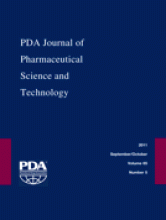Abstract
A leak test performed according to ASTM F2338-09 Standard Test Method for Nondestructive Detection of Leaks in Packages by Vacuum Decay Method was developed and validated for container-closure integrity verification of a lyophilized product in a parenteral vial package system. This nondestructive leak test method is intended for use in manufacturing as an in-process package integrity check, and for testing product stored on stability in lieu of sterility tests. Method development and optimization challenge studies incorporated artificially defective packages representing a range of glass vial wall and sealing surface defects, as well as various elastomeric stopper defects. Method validation required 3 days of random-order replicate testing of a test sample population of negative-control, no-defect packages and positive-control, with-defect packages. Positive-control packages were prepared using vials each with a single hole laser-drilled through the glass vial wall. Hole creation and hole size certification was performed by Lenox Laser. Validation study results successfully demonstrated the vacuum decay leak test method's ability to accurately and reliably detect those packages with laser-drilled holes greater than or equal to approximately 5 μm in nominal diameter. All development and validation studies were performed at Whitehouse Analytical Laboratories in Whitehouse, NJ, under the direction of consultant Dana Guazzo of RxPax, LLC, using a VeriPac 455 Micro Leak Test System by Packaging Technologies & Inspection (Tuckahoe, NY). Bristol Myers Squibb (New Brunswick, NJ) fully subsidized all work.
LAY ABSTRACT: A leak test performed according to ASTM F2338-09 Standard Test Method for Nondestructive Detection of Leaks in Packages by Vacuum Decay Method was developed and validated to detect defects in stoppered vial packages containing lyophilized product for injection. This nondestructive leak test method is intended for use in manufacturing as an in-process package integrity check, and for testing product stored on stability in lieu of sterility tests. Test method validation study results proved the method capable of detecting holes laser-drilled through the glass vial wall greater than or equal to 5 μm in nominal diameter. Total test time is less than 1 min per package. All method development and validation studies were performed at Whitehouse Analytical Laboratories in Whitehouse, NJ, under the direction of consultant Dana Guazzo of RxPax, LLC, using a VeriPac 455 Micro Leak Test System by Packaging Technologies & Inspection (Tuckahoe, NY). Bristol Myers Squibb (New Brunswick, NJ) fully subsidized all work.
- ASTM F2338
- Container closure
- Container-closure integrity
- Defects
- Glass vial
- Glass vial defects
- Leak
- Leakage
- Leak detection
- Leak test method
- Lyophilized product
- Package
- Package defects
- Package integrity
- Package integrity method
- Vacuum decay
- Vacuum decay leak detection
- VeriPac
- © PDA, Inc. 2011
PDA members receive access to all articles published in the current year and previous volume year. Institutional subscribers received access to all content. Log in below to receive access to this article if you are either of these.
If you are neither or you are a PDA member trying to access an article outside of your membership license, then you must purchase access to this article (below). If you do not have a username or password for JPST, you will be required to create an account prior to purchasing.
Full issue PDFs are for PDA members only.
Note to pda.org users
The PDA and PDA bookstore websites (www.pda.org and www.pda.org/bookstore) are separate websites from the PDA JPST website. When you first join PDA, your initial UserID and Password are sent to HighWirePress to create your PDA JPST account. Subsequent UserrID and Password changes required at the PDA websites will not pass on to PDA JPST and vice versa. If you forget your PDA JPST UserID and/or Password, you can request help to retrieve UserID and reset Password below.






